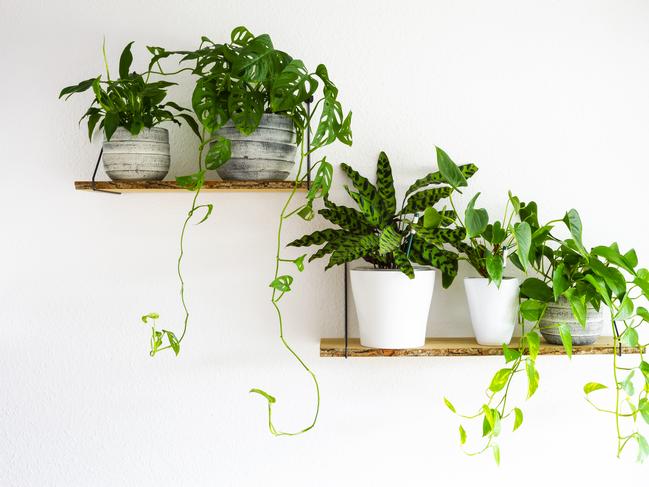Indoor plants tips, How to get around building supply crisis, Why your garden is ‘going berserk’ – and what to do
Those old enough to remember the ‘70s will know that no home was complete without an array of these, as a whole new generation is learning now.

Lifestyle
Don't miss out on the headlines from Lifestyle. Followed categories will be added to My News.
You’re probably already familiar with the term ‘plant parent’ and, depending on what generation you belong to, you either think it’s a lot of nonsense or the first steps in responsible adulting. Those old enough to remember the ’70s will know that no home was complete without an array of house plants to add life to every room.
But somewhere during the ’90s, it all became a bit naff and growing plants indoors was about as popular as tiled orange benchtops.

Fast forward to the early 21st century and Gen Z renters are stressing over who will care for their leafy babies if they go away for the weekend. As with any popular movement, you can pay high prices for indoor plants – and lose your money if they turn up your toes. But horticulturist Angie Thomas, from Yates, says you can be a great plant parent with little cash, even if you’ve never grown indoor plants before.
Q. How do I start my plant family with a tight budget?
A. You’re after maximum return on investment, so start with hard-to-kill plants suited to the low light conditions experienced indoors. Angie says the trailing Devil’s Ivy is both beautiful and tough as nails.
“There are some really bulletproof plants to start with like Devil’s Ivy, also known as Pothos, that are multipurpose, grown in a hanging basket or on shelves with cascading foliage,” she says.
“They are a really good plant to start off with because they grow quite quickly and they are pretty tolerant of low levels of light.”
Others might prefer the architectural look of Mother in Law’s Tongue or the leafy round shape of the Peace Lily.
The Spider plant is also a popular choice for hanging baskets.

Depending on the size, you can pick them up from the nursery for as little as $10.
If you have little or no experience growing pot plants, the temptation is to water them regularly. The problem is, says Angie, you may end up effectively killing them with kindness.
“The best way to check whether a plant needs water is to stick your finger into the soil and see if it feels dry,” she says.
“We tend to over love our plants with watering because we are so desperate to be doing something. But when we do this, we can water log the roots and they rot.”
Also, it’s important to make sure your plant is free draining, even if it means leaving it in the bathtub or sink for a short while to prevent root rot.
Q, I hear people talk about taking cuttings and striking plants. please explain?
A. Taking a cutting means growing, or striking, a new plant from the stem or even the leaf of an existing plant – and it’s a great way to grow new plants for free.
You can do this with trailing parts of Devil’s Ivy, just by cutting a piece off and pressing the cut end into potting mix or even leaving it in water.
“If you use water, you should start to see some sort of shoots or growth within just a couple of weeks,” says Angie.
“Treat it almost like cut flowers. Add fresh, clean water to promote the healthy development of roots.

” Once it shoots out a few roots, you can either continue to keep it in water or transplant it into potting mix.
“Keep the plant moist for the first month afterwards because it can be a bit of a shock going directly from water to soil,” says Angie.
The Spider plant also has a habit of putting out ‘spiderettes’, or mini plants on longer stems.
Angie says these are perfect for starting new plants.
“You can put a pot right next to an existing Spider plant and then weigh down the spiderette in the smaller pot until it sends roots into the soil,” she adds.
Q. Can I grow succulents from a cutting?
A. Succulents are super easy to propagate from cuttings, just by cutting off pieces of fleshy stem from a healthy plant, or even just a few leaves.
Often, they need nothing more than good quality potting mix to get going, but you can dip the raw end of the cutting in root hormone powder or gel to move things along. Angie says they do need certain conditions to thrive but plants like aloe vera, jade plant, zebra cactus and string of pearls all manage well indoors.

“You need to keep in mind that a lot of them are used to desert environments where it is dry with direct sun all day,” she says.
“They are best placed in your sunniest spots with a bit of direct light.”
As with all potted plants, they are prone to drying out, so it’s important to be aware of how your plants are faring.
Furled or yellowing leaves might be a sign of too little water, or too much, or that they could do with a feed.
For what it’s worth, Angie says the parenting analogy has its merits.
“Be present as a parent.”
HOW TO OUTSMART THE BUILDING SUPPLY CRISIS
The current building boom has been fraught with material supply delays. What can you do to speed up your build?
One of the stranger outcomes of Covid is that building and construction have never been busier. After all that time working from home, many of us have decided that the building or renovation project we’ve been talking about for years needs to get moving – and right now. With trades in high demand and some building materials in very scarce supply, architect Mark Szczerbicki says it’s more important than ever that your renovation project is well organised so that it runs as smoothly as possible so you can be right on time.

I’m hoping to get my building project done this year. How can I speed up the build?
Mark says the past two years have been the busiest he has ever known, and he’s not alone. But while there is a lot of demand on the industry, it’s also a great time to build.
“We have been getting projects approved a bit faster,” he says. “Councils, it seems, are keen to keep everyone busy.”
If you’re keen to move things along, Complying Development (CDC) will fast track your approval, as long as it meets pre-approved criteria governing things such as heights and floorspace. It can transform the approval process, cutting it down to a matter of weeks rather than months.
“We have done as much CDC as possible,” says Mark.
“It’s about the certainty of getting what we would like without having to jump through hoops with council and neighbours’ objections.
“We have had very few projects where, if you could do a CDC, the clients have chosen to do a DA (Development Approval) instead.”

Are there any other tricks to speeding up my build?
The best way to make your build run on time is to be prepared. Mark says a well organised project without any variations to the agreed plans is your best bet for a consistent workflow on site. Ensuring you have a good team on your side will also speed things up. “People often think that by not paying a professional and managing it themselves that they will save time and money, but we find that the opposite happens,” he says. “The cost of hiring a design professional far outweighs the cost of delays on site and the costs of things like renting for longer.”
But in a Covid climate, don’t expect too much. Mark says an average six-month build is now more likely to take eight months. Your best asset may be patience.
How does my choice of building materials affect the speed of the job?
Thanks to Covid and domestic and international quarantining, the supplies of some materials have been delayed or fallen short of demand. Australia usually supplies about 80 per cent of its own timber but the 2019 bushfires also wiped out vast hectares of plantation forests, leaving the building industry under supplied. Mark says if you’re not willing to wait, there are other options.

“Sometimes people will order concrete (for floors) because they know there will not be a delay and they would rather not risk it going over time,” he says.
Products such as Dincel, a type of plastic framing for pouring concrete into to create walls, has started to move from the commercial building sector into the residential market because it dramatically cuts down on construction times.
Also, increasingly, Mark says, builders are pre-ordering materials as soon as contracts are signed.
“Normally, there would be a couple of weeks into the job, doing demolition, before they ordered the timber framing in,” he says. “But what took a week to arrive now takes eight weeks.”
If you want your project to progress without delay, he suggests having everything from taps and tiles delivered prior to work starting. “If you are ordering early, you need somewhere to stockpile things,” he says.
WHY YOUR GARDEN IS GOING BERSERK – AND WHAT TO DO ABOUT IT
The La Nina weather pattern has brought slightly cooler temperatures and greater rainfall over eastern and Northern Australia meaning perfect conditions for astonishing garden growth. Horticulturist and landscape designer Adam Robinson says the rain, along with the natural nitrogen it contains, means “everything is going berserk”.
That’s great but it does mean that, in many cases, it’s time to drag out the garden tools lest you find yourself overwhelmed by an urban jungle?
Read on for tips.
Q. Everything has gone crazy in my garden. I normally only prune in autumn and winter. what to do?
A. It’s perfectly fine to do nothing, says Adam. But if it’s bothering you, time to act.
“If the garden is growing out of hand, I am sure the plants are fine, but if it’s growing across a pathway, you can prune it down,” he says.
The ideal time to prune is when your tree or shrub has finished flowering, usually in autumn or winter in preparation for the new growth season in spring. Given there is so much rain around and it’s still warm, Adam says it’s fine to do now.

“If the plants are already growing well in full sun, there’s no real risk of damage,” he says.
Where your plants are continuing to flower, such as late flowering grevilleas or lavender, Adam suggests you prune every second or third branch so that you are still allowing for flowers, but keeping the plant under good control.
Q. Is this weather affecting indoor plants as well?
A. Given they are not exposed directly to the weather, you’d think indoor plants would be carrying on as normal. However, Adam says there is more humidity this summer, resulting in higher moisture levels in the air. This means you can cut back on the watering for starters.
“Our offices were closed for four weeks over Christmas,” Adam says.
“I went in there to check on the plants because nothing had been watered and everything was thriving. You can hold off on irrigation systems, even for indoor plants because there’s so much moisture in the air, they just don’t need as much watering.”

Q. What about the lawn? I can almost watch the grass grow at the moment
A. Lawns are certainly having a moment right now.
Where usually you might happily mow every two or even three weeks throughout the summer, Adam says this year, you need to up the schedule and considerably too.
“I’d say once a week for mowing right now,” he says.
“It’s good to keep on top of it. If you let it grow too long it can look a bit ugly and worse, there’s potential it will get a bit thatchy.”

Mushrooms are popping up in lawns and garden beds as well thanks to all of that extra moisture.
Apart from the obvious advice not to eat them, Adam says you have a couple of options here.
Firstly, if they don’t offend you, or you actually enjoy seeing a touch rewilding going on, you can leave them be.
Otherwise, you can just yank them out easily enough.
“We should also be keeping an extra eye out for fungal problems such as sooty mould and frangipani rust,” he says.
“If you see any evidence of that, spray them with an antifungal treatment,” advises Adam.
Robyn Willis is The Fixer. here to answer all your home improvement, renovation and repair questions. Email us at athome@news.com.au
More Coverage
Originally published as Indoor plants tips, How to get around building supply crisis, Why your garden is ‘going berserk’ – and what to do




